DT Exam Revision
Plastics. Symbols. Symbols. Properties. Uses. Hip replacement. Medical uses[edit] Total hip replacement is most commonly used to treat joint failure caused by osteoarthritis.

Other indications include rheumatoid arthritis, avascular necrosis, traumatic arthritis, protrusio acetabuli, certain hip fractures, benign and malignant bone tumors, arthritis associated with Paget's disease, ankylosing spondylitis and juvenile rheumatoid arthritis. The aims of the procedure are pain relief and improvement in hip function. Hip replacement is usually considered only after other therapies, such as physical therapy and pain medications, have failed.
Risks[edit] Dislocated artificial hip Hip prosthesis displaying aseptic loosening (arrows) Risks and complications in hip replacement are similar to those associated with all joint replacements. Vein thrombosis[edit] Venous thrombosis such as deep vein thrombosis and pulmonary embolism are relatively common following hip replacement surgery. Dislocation[edit] Fracture[edit]
PETE. Properties. Uses. Polypropylene stacking chair. Hille Polypropylene Chair (1963) Hille Polypropylene Armchair with ski base (1967) This is one of the very few chairs that after over 40 years is still in production and has been made in forty countries around the world, for schools, hospitals, airports, canteens, restaurants, arenas, hotels, as well as homes.[1] It is the best-selling chair in the world.[2]
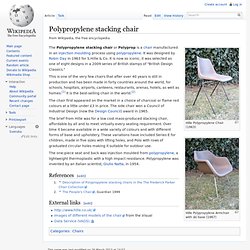
Properties. Uses. Properties. Uses. HDPE. Properties. Washing up liquid buttles. Thermosetting. The Beach Boys. The Beach Boys are an American rock band, formed in Hawthorne, California in 1961.
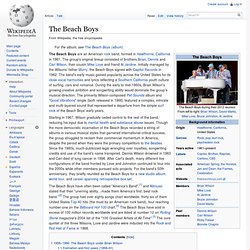
The group's original lineup consisted of brothers Brian, Dennis and Carl Wilson, their cousin Mike Love and friend Al Jardine. Initially managed by the Wilsons' father Murry, the Beach Boys signed with Capitol Records in 1962. The band's early music gained popularity across the United States for its close vocal harmonies and lyrics reflecting a Southern California youth culture of surfing, cars and romance. During the early to mid-1960s, Brian Wilson's growing creative ambition and songwriting ability would dominate the group's musical direction.
Marmite. A version with a different flavour[1] has been manufactured in New Zealand since 1919.
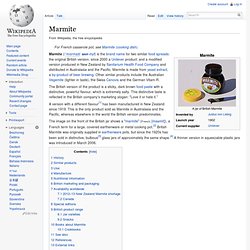
This is the only product sold as Marmite in Australasia and the Pacific, whereas elsewhere in the world the British version predominates. History[edit] The product's popularity prompted the Sanitarium Health Food Company to obtain sole rights to distribute the product in New Zealand and Australia in 1908.[8] They later began manufacturing Marmite under licence in Christchurch, albeit using a modified version of the original recipe, most notable for its inclusion of sugar and caramel.[1] Common ingredients are also slightly different quantities from the British version;[1] the New Zealand version has high levels of potassium, for example.
Supermarine Spitfire. The Supermarine Spitfire is a British single-seat fighter aircraft that was used by the Royal Air Force and many other Allied countries during and after the Second World War.

The Spitfire was built in many variants, using several wing configurations, and was produced in greater numbers than any other British aircraft.
Mini. Industrial Processes. Physical Processes. Train wheel. Flanged railway wheel A train wheel or rail wheel is a type of wheel specially designed for use on rail tracks.

A rolling component is typically pressed onto an axle and mounted directly on a rail car or locomotive or indirectly on a bogie, also called a truck. Wheels are cast or forged (wrought) and are heat treated to have a specific hardness. New wheels are trued, using a lathe, to a specific profile before being pressed onto an axle. All wheel profiles need to be periodically monitored to insure proper wheel-rail interface.
Steam bending. The wood roof shingles on this onion dome were bent to match the curves of the dome.
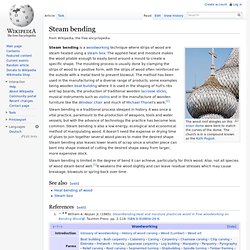
The church is in a compound known as the Kizhi Pogost. Steam bending is a woodworking technique where strips of wood are steam heated using a steam box.
Rocking chair. Karin Larsson-Bergöö's rocking chair A man in a rocking chair.

A rocking chair or rocker is a type of chair with two curved bands (also known as rockers) attached to the bottom of the legs, connecting the legs on each side to each other. The rockers contact the floor at only two points, giving the occupant the ability to rock back and forth by shifting his/her weight or pushing lightly with his/her feet.[1][2] Rocking chairs are most commonly made of wood.
Some rocking chairs can fold.
Gas metal arc welding. Gas metal arc welding Development[edit] The principles of gas metal arc welding began to be understood in the early 19th century, after Humphry Davy discovered the short pulsed electric arcs in 1800.[1] Vasily Petrov independently produced the continuous electric arc in 1802 (soon followed by Davy).[1] It was not until the 1880s that the technology became developed with the aim of industrial usage.

At first, carbon electrodes were used in carbon arc welding. By 1890, metal electrodes had been invented by Nikolay Slavyanov and C. L. In 1948, GMAW was finally developed by the Battelle Memorial Institute. As noted, GMAW is currently one of the most popular welding methods, especially in industrial environments.
Shipbuilding. An expedition's shipwrights building a brigantine, 1541.
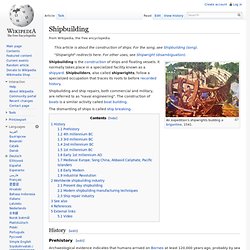
Shipbuilding is the construction of ships and floating vessels. It normally takes place in a specialized facility known as a shipyard. Shipbuilders, also called shipwrights, follow a specialized occupation that traces its roots to before recorded history. Shipbuilding and ship repairs, both commercial and military, are referred to as "naval engineering".
Automotive industry. The automotive industry is a wide range of companies and organizations involved in the design, development, manufacture, marketing, and selling of motor vehicles.[1] It is one of the world's most important economic sectors by revenue. The automotive industry does not include industries dedicated to the maintenance of automobiles following delivery to the end-user, such as automobile repair shops and motor fuel filling stations. The term automotive was created from Greek autos (self), and Latin motivus (of motion) to represent any form of self-powered vehicle.
This term was proposed by SAE member Elmer Sperry.[2] History[edit]
Moulding Processes. Sand Casting. Cylinder block. A modern passenger car engine block, integrating the crankcase and all cylinders. The cylinder head bolts to the deck surface at top. Many ribs and bosses can be seen on the side of the casting. This block is for a straight-six engine.
Injection moulding. Cast vs wrought. Properties. Blow Moulding. Non Ferrous.
Damn autocorrect
Ferrous. Properties. Uses. Properties. Uses. Woods. Softwoods. Hardwoods. Ceramic. Ceramic. Properties. Uses. Properties. Uses. Properties. Uses.










